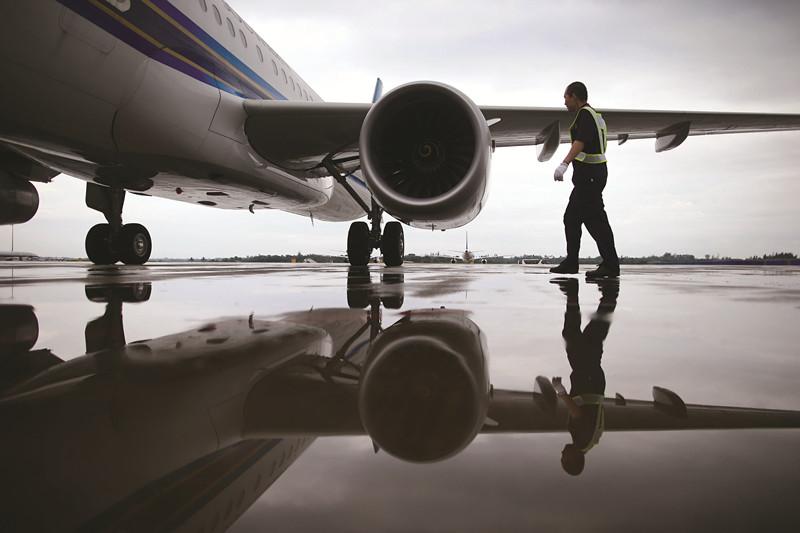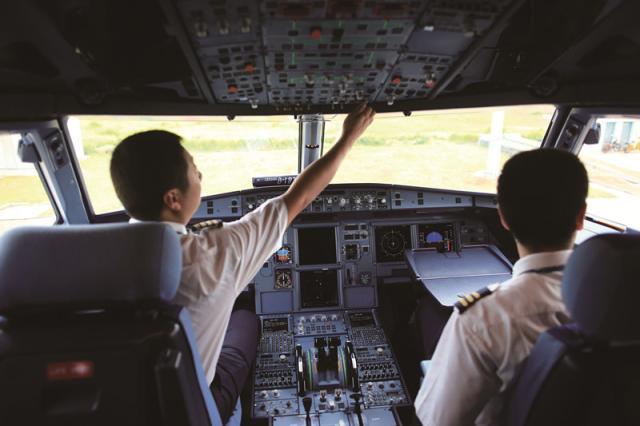
 Old Version
Old Version
Pilot Shortfall
On May 8, 2017, the Civil Aviation Administration of China (CAAC) released its annual development report, revealing that China’s civil aviation fleet had increased to 2,950 aircraft by the end of 2016, an increase of 10.8 percent year on year. Alongside the expanding market and the steady increase of aircraft, however, a pilot shortage continues to throttle the civil aviation industry.
“It is high time to clarify exactly what we mean and reduce confusion,” a senior official of CAAC told NewsChina on condition of anonymity. He said that generally speaking, anyone who has a license could theoretically be categorized as a pilot, including civil aviation pilots, flight instructors, trainees, private pilots and pilots of sporting aircraft. The shortage of pilots, he said, refers to those who fill civil aviation cockpits – pilots-in-command (captains) and assistant captains (also known as co-pilots).
According to the CAAC annual report, over 50,500 pilots held a current civil aviation license in China as of the end of 2016, an increase of 10.9 percent year on year, roughly matching the rising number of aircraft. Chinese airlines had a total of nearly 14,400 captains and 16,900 assistant captains on duty.
On any one flight, a captain and an assistant captain will work in pairs. According to the safety rules of CAAC, keeping an aircraft operating on a constant rotation needs at least eight pilots, as each pair need rest and recreation time.
The CAAC official noted that the number of pilots in China can basically meet the needs of the growing market. Official statistics show that in 2016 more than 3,500 pilots were born in 1989 or later, accounting for the majority of new pilots. In addition, most captains were born in 1983 or later. CAAC expects that the number of captains in China will reach a peak in the next decade.
In contrast to the optimism of the authorities, however, industry insiders are quite pessimistic. They argue that even if China’s overall number of pilots is sufficient, there is a shortage of pilots in specific areas of the industry and the distribution of pilots among airlines is highly unbalanced.
Zou Jianjun, professor of the Civil Aviation Management Institute of China, told NewsChina that the pilot shortage actually refers to the shortage of captains. He describes it as a structural shortage, particularly for large aircraft and international flights.
He said that China’s Big Three airlines – Air China, China Eastern and China Southern – have an “OK reserve of pilots” but for smaller airlines and start-up companies, a shortage has become the norm. Xiamen Air plans to recruit 600 pilot trainees in 2017, offering them free training. The firm says that they face a shortage of 2,500 pilots in the next five years.
According to Zhang Qihuai, secretary-general of the Air Law Research Association of Beijing Law Society, the number of captains on the books represents only a perfect situation, not the reality on the ground – or in the air – every day. At any one point, some captains will be on vacation, ill, be in the training they need to do twice a year, or be in-between jobs. One captain, who has flown more than 14,000 hours, told NewsChina anonymously that although the nominal number of pilots in China is adequate, the number actually working is far from enough.
According to CAAC’s plans, the number of civil aircraft in China will hit 4,600 by the end of 2020, while the overall fleet of aircraft will have reached nearly 10,000. That means the country will be adding roughly 412 aircraft every year, and given this growth, they’ll need nearly 10,000 new captains over this period.
According to Zhang, in the next four years, over 5,000 assistant captains will become captains and more than 600 captains will retire. He added that China requires roughly 5,000 captains by the end of 2020, if captains recruited from other countries are not taken into account. As of the end of 2016, over 1,000 foreign captains were working for domestic airlines.
According to the aviation rules of CAAC, a captain can fly no more than 1,000 hours per year and the authorities are already mulling cutting the flying hours by 10 percent. If this new regulation is implemented, the shortage will become more acute. An insider who declined to be named said that it is difficult to achieve the goal of adding 412 aircraft each year for domestic airlines, but it is highly possible for 300 aircraft to be added to the fleet each year.
The shortage of helicopter pilots is even more severe. China is currently home to only 2,830 helicopter pilots and by 2020, 8,000 helicopter pilots will be required.

Pilots make the final adjustment to an aircraft before take-off, June 12, 2014
Over the past 10 years, there has been a rapidly growing market for pilot training in China, with an annual growth of 12 percent year on year, in a bid to address the pilot shortfall. The Civil Aviation Flight University of China trained over half of the pilots in China over the past 50 years.
By the end of 2016, there were 20 pilot training schools nationwide with a training capacity of 3,450 students.
It costs a huge amount of time and money to train a pilot. The senior pilot who declined to be named told our reporter that it takes at least eight to ten years to become a captain and 15 years to fly a large aircraft. What’s more, it costs at least 750,000 yuan (US$110,000) to train a pilot at an institution. After graduation, pilots need to receive internal training continuously and accumulate a fixed amount of flying time at an airline before becoming a fully-fledged pilot.
What’s more, pilots have to receive on-the-job training annually which also costs a stupendous amount of money. Generally speaking, it costs three to five million yuan (US$440,000 to $734,000) to train a captain.
Li Xiaojin, a professor at the Civil Aviation Flight University of China, told NewsChina that the growing training capacity has alleviated the imbalance between the supply and demand of pilots in recent years, but in the long term he is not optimistic, particularly in terms of the physical qualifications of students.
“Piloting is a very risky profession that requires an extremely high physical, mental and educational level. The problem nowadays is that many trainees are in a poor physical health,” he said. Nowadays, only 3 percent of applicants can pass the physical examination and their eyesight is the most problematic issue. Since 2014, he said, the vision criteria to be a pilot have been lowered and applicants who are slightly nearsighted can also pass the tests.
In addition to the problem of supply and demand, the fearsome demands put on pilots by airlines are severely cutting trainee numbers. Airlines currently require trainees to sign life-long contracts, and force them to pay literally millions of yuan in compensation if they resign. Once a captain resigns from one airline, the regulations generally forbid him or her from working for another airline for two years. In 2013, 496 pilots from 15 airlines delivered a joint petition to the CAAC, asking to abolish the restrictions on the job movement of pilots. Statistics showed that at least 2.5 percent of China’s total number of pilots are currently not working thanks to their involvement in legal disputes.
In 2015, among the 311 pilots who resigned, 77.5 percent reached a settlement after negotiation with airlines, a substantial increase on previous years. From 2010 to 2014, at least half of the cases were settled through civil procedures or labor arbitration. In 2016, 356 pilots landed a new job and most of the cases were settled through legal means. The China Air Transport Association is currently consulting with airlines to guide and regulate the mobility of pilots.
Zou Jianjun argued that the main reason for the difficulty in the mobility of civil aviation pilots lies in the shortage of senior pilots, which means captains have become the core assets of each airline. Under such circumstances, he said, job-hopping has been upgraded to the level of the “loss of State assets.” Zou is currently working on a research project, trying to mobilize any pilots not currently working.
“The preliminary design is to establish a platform in which all idle pilots are priced based on their age, flying hours, technique and experience. Their relationship with the company will remain the same, but the highest bidders could hire the pilot,” he said.

A tutor teaches pilot trainees at Binzhou University in Shandong Province, July 11, 2010